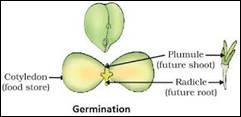In a germinating seed, which parts are known as future shoot and future root? Mention the function of cotyledon.
In the germinating seed:
The plumule is the future shoot. It will develop to become the shoot. The plumule can be found between two cotyledons.
The radicle is the future root. It develops to become the future root.
Plumule and radicle are two parts of the plant embryo, which are found inside the seed. During the germination of the seed, radicle is developed at first through the micropyle of the seed. The radicle is the rudimentary root of the plant embryo. It grows downward into the soil, absorbing water required by the further development of the embryo. Radicle develops into the root system of the future plant. Plumule emerges secondly to the radicle from the seed. It grows upwards from the soil. Cotyledons are held by plumule. Plumule is capable of photosynthesizing, producing the food required by the growth of the embryo. It develops into the shoot of the future plant, consisting of stem and leaves. However, the main difference between plumule and radicle is in their development into different parts of the future plant.

A cotyledon is part of the embryo within the seed of a plant. Often when the seed germinates, or begins to grow, the cotyledon may become the first leaves of the seedling. The cotyledons are formed during the process of embryogenesis along with the roots and shoots of the plant prior to germination.
Functions of cotyledon:
a) Photosynthesis
The cotyledons in some cases are major photosynthetic producers during germination. As photosynthetic producers, cotyledons essentially can synthesize the organic nutrients it requires for growth through photosynthesis.
b) Leaf Growth/Food
The cotyledon encourages leaf growth in a plant's early stages of life. These leaves are important because they serve as the chief way for plants to get the nutrients they need to continue growing and thriving. When cotyledons become new green leaves, the cotyledons raise over ground level. In another process that involves plants such as peas, however, cotyledons remain underground and solely serve the function of a food source.
Cotyledons transmit the food stored in the embryo to new sprouting plants. Plants such as beans and peas -- which are dicotyldons -- have thick cotyledons that drew nutrients from the seeds prior to sprouting. Meanwhile, grass -- an example of a monocotyledonous -- has a single thin cotyledon that absorbs nutrients from the seeds as they are sprouting.
c) Reproduction
The cotyledon essentially allows a plant's embryo to begin creating new life following germination. This is a critical function because it shows that without the cotyledon, a plant essentially would not be able to breed. With the help of the cotyledon, plants can spread their seeds and boost their species' population at a rapid rate.